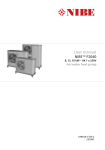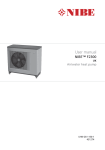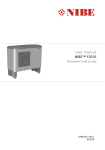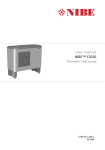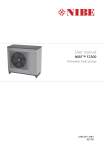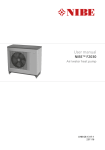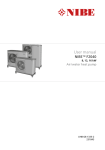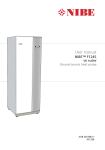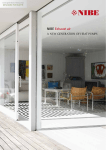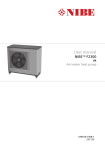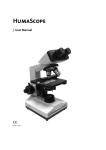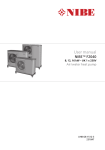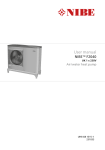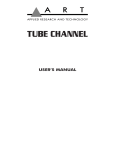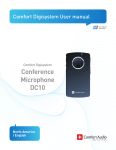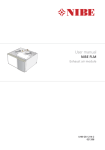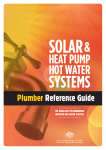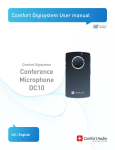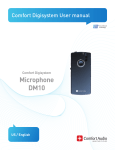Download User manual
Transcript
User manual NIBE™ F2016 UK 1x230V LEK Air/water heat pump UHB GB 1244-2 031884 Table of Contents 1 Important information 2 Installation data Safety information Serial number Country specific information F2016 - An excellent choice 2 4 5 5 7 2 The heat pump – the heart of the house Heat pump function Contact with F2016 Maintenance of F2016 3 Disturbances in comfort 8 8 10 11 16 Troubleshooting 16 4 Technical data 5 Glossary 19 20 Item register Table of Contents | 24 NIBE™ F2016 1 1 Important information Installation data Product F2016 Serial number Installation date Installer Serial number must always be given Certification that the installation is carried out according to instructions in NIBE's installer manual and applicable regulations. Date 2 __________________ Chapter 1 | Important information Signed _________________________ NIBE™ F2016 Chan- Name nel Default Set settings A1 Communications address 1 A3 Connection diff. return temp. 4 °C A4 Start interval compressor 20 min A5 Balance temperature 0 °C A6 Time delay addition relay 120 min A7 Stop temperature -15 °C A8 Min. interval between 60/50 defrosting /45 A9 Start defrosting ✔ Accessories +1 °C A10 Stop defrosting +10 °C A11 Longest defrosting 7 min Chapter 1 | Important information NIBE™ F2016 3 Safety information This appliance is not intended for use by persons (including children) with reduced physical, sensory or mental capabilities, or lack of experience and knowledge, unless they have been given supervision or instruction concerning use of the appliance by a person responsible for their safety. Children should be supervised to ensure that they do not play with the appliance. Rights to make any design or technical modifications are reserved. ©NIBE 2012. Symbols NOTE This symbol indicates danger to machine or person. Caution This symbol indicates important information about what you should observe when maintaining your installation. TIP This symbol indicates tips on how to facilitate using the product. Marking F2016 is CE marked and fulfils IP24. The CE marking means that NIBE ensures that the product meets all regulations that are placed on it based on relevant EU directives. The CE mark is obligatory for most products sold in the EU, regardless where they are made. IP24 means that the product is secure against penetration by objects with a diameter larger than or equivalent to 12.5 mm and that the product is protected against drops from all directions. 4 Chapter 1 | Important information NIBE™ F2016 Serial number The serial number can be found on the product's foot. LEK 6HULDO QXPEHU Caution Always give the product's serial number when reporting a fault. Country specific information Great Britain This installation is subject to building regulation approval, notify the local Authority of intention to install. Use only manufacturer’s recommended replacement parts. Nibe is a licensed member of the Benchmark Scheme which aims to improve the standards of installation and commissioning of domestic heating and hot water systems in the UK and to encourage regular servicing to optimise safety, efficiency and performance. Chapter 1 | Important information NIBE™ F2016 5 Benchmark is managed and promoted by the Heating and Hotwater Industry Council. For more information visit www.centralheating.co.uk Warranty and insurance information Thank you for installing a new NIBE heat pump in your home. NIBE heat pumps are manufactured in Sweden to the very highest standard so we are pleased to offer our customers a comprehensive guarantee. The product is guaranteed for 24 months for parts and labour from the date of installation or 33 months from the date of manufacture, whichever is the shorter. The NIBE guarantee is based on the unit being installed and commissioned by a NIBE accredited installer, serviced every year and the Benchmark documents completed. Where this condition is not met, any chargeable spare parts or components issued within the applicable guarantee period still benefit from a 12 month warranty from the date of issue by the manufacturer. We recommend the installer completes and returns as soon as possible, your guarantee registration card or completes the guarantee form on the NIBE website www.nibe.co.uk. Please ensure that the installer has fully completed the Benchmark Checklist in the end of the Installation Instructions supplied with the product and that you have signed to say that you have received a full and clear explanation of its operation. The installer is legally required to complete a commissioning checklist as a means of complying with the appropriate Building Regulations (England and Wales). All installations must be notified to Local Area Building Control either directly or through a Competent Persons Scheme. A Building Regulations Compliance Certificate will then be issued to the customer who should, on receipt, write the Notification Number on the Benchmark Checklist. This product should be serviced regularly to optimise its safety, efficiency and performance. The service engineer should complete the relevant Service Record on the Benchmark Checklist after each service. The Benchmark Checklist may be required in the event of any warranty work and as supporting documentation relating to home improvements in the optional documents section of the Home Information Pack. 6 Chapter 1 | Important information NIBE™ F2016 F2016 - An excellent choice F2016 is an air/water heat pump specially developed for the Nordic climate, which utilises the outside air so there is no need for bore holes or coils in the ground. The heat pump is intended for connection to water borne heating systems and can both heat hot water effectively at high outdoor temperatures and give a high output to the heating system at low outdoor temperatures. If the outdoor temperature drops to a level below the stop temperature all heating must then occur with external additional heat. Excellent properties for F2016: ႑ Efficient scroll compressor Efficient scroll compressor that operates at temperatures down to -15 °C. ႑ Intelligent control Integrated intelligent control for optimum control of the heat pump. F2016 is started by a start signal from another unit (VVM 300 for example) or thermostat. ႑ Fan With the exception of F2016-6 kW (which only has one fan speed) F2016 has an automatic 2-step capacity control of the fan. ႑ Long service life The material has been chosen for a long service life. ႑ Many possibilities F2016 can also be used together with most electric boilers, oil boilers or similar. Chapter 1 | Important information NIBE™ F2016 7 2 The heat pump – the heart of the house Heat pump function H +HDWLQJ PHGLXP 5HIULJHUDQW I %ULQH 45 °C 55 °C G E 80 °C &RQGHQVHU Kondensor Expansionsventil ([SDQVLRQ YDOYH F 0 °C Kompressor &RPSUHVVRU Förångare (YDSRUDWRU D 5 °C C B -3 °C +HDW VRXUFH A 2 °C The temperatures are only examples and may vary between different installations and time of year. 8 Chapter 2 | The heat pump – the heart of the house NIBE™ F2016 An air/water heat pump can use the outdoor air to heat a property. The conversion of the outdoor air's energy to property heating occurs in three different circuits. In the brine circuit, (1) , free heat energy is retrieved from the surroundings and transported to the heat pump. In the refrigerant circuit, (2) , the heat pump increases the retrieved heat's low temperature to a high temperature. In the heating medium circuit, (3) , the heat is distributed around the house. A B C D E F G H Outdoor air The outdoor air is sucked into the heat pump. The fan then routes the air to the heat pump’s evaporator. Here, the air releases the heating energy to the refrigerant and the air's temperature drops. The cold air is then blown out of the heat pump. Refrigerant circuit A gas circulates in a closed system in the heat pump, a refrigerant, which also passes the evaporator. The refrigerant has a very low boiling point. In the evaporator the refrigerant receives the heat energy from the outdoor air and starts to boil. The gas that is produced during boiling is routed into an electrically powered compressor. When the gas is compressed, the pressure increases and the gas's temperature increases considerably, from 5 °C to approx. 80°C. From the compressor, gas is forced into a heat exchanger, condenser, where it releases heat energy to the heating system in the house, whereupon the gas is cooled and condenses to a liquid form again. As the pressure is still high, the refrigerant can pass an expansion valve, where the pressure drops so that the refrigerant returns to its original temperature. The refrigerant has now completed a full cycle. It is routed to the evaporator again and the process is repeated. Heat medium circuit The heat energy that the refrigerant produces in the condenser is retrieved by the climate system's water, heating medium, which is heated to 55 °C (supply temperature). The heating medium circulates in a closed system and transports the heated water's heating energy to the house water heater and radiators/heating coils. The temperatures are only examples and may vary between different installations and time of year. Chapter 2 | The heat pump – the heart of the house NIBE™ F2016 9 Contact with F2016 F2016 has an integrated control system that checks and monitors the heat pump operation. At installation the installer makes the necessary settings of the control system so that the heat pump will work optimally in your system. The heat pump is controlled in different ways depending on what your system looks like. If you have an indoor module, for example VVM 300, or a control module, for example SMO 10 the heat pump can be controlled from these. Refer to the relevant manual for further information. 10 Chapter 2 | The heat pump – the heart of the house NIBE™ F2016 Maintenance of F2016 Regular checks When your heat pump is located outdoors some external maintenance is required. NOTE Insufficient oversight can cause serious damage to F2016 which is not covered by the guarantee. Checking grilles Check that the inlet grille is not clogged by leaves, snow or anything else regularly throughout the year. Pay extra attention in event of high winds or snowfall that may cause the grille to be blocked. LEK Prevent snow building up and covering the grille on F2016. LEK Keep free of snow and/or ice. Chapter 2 | The heat pump – the heart of the house NIBE™ F2016 11 Cleaning the outer casing If necessary the outer casing can be cleaned using a damp cloth. Care must be exercised so that the heat pump is not scratched when cleaning. Avoid spraying water into the grilles or the sides so that water penetrates into F2016. Prevent F2016 coming into contact with alkaline cleaning agents. Condensation drain pan and condensation water pipe The condensation drain pan and condensation water/drain pipe may require cleaning from leaves or similar during the year. Cleaning 1. Use the safety switch to cut the incoming electrical supply. 2. Release the trough using the quick release catches on the left and right front edges. Keep in position at the rear edge without stretching the power cable. 3. Clean drain pans and condensation water pipe/drains. 4. Reinstall the trough using the removal method in reverse order (see point 2). 5. Switch on the safety switch again. In event of long power cuts In the event of prolonged power failures it is recommended that the part of the heating system located outdoors is drained. Your installer has fitted a shutoff and a drain valve to facilitate this. Ask you installer if you are unsure. Saving tips Your heat pump installation produces heat and/or hot water. This occurs via the control settings you made. Factors that affect the energy consumption are, for example, indoor temperature, hot water consumption, the insulation level of the house and whether the house has many large window surfaces. The position of the house, e.g. wind exposure is also an affecting factor. Also remember: ႑ 12 Open the thermostat valves completely (except in the rooms that are to be kept cooler for various reasons, e.g. bedrooms). The thermostats slow the flow in the heating system, which the heat pump wants to compensate Chapter 2 | The heat pump – the heart of the house NIBE™ F2016 with increased temperatures. It then works harder and consumes more electrical energy. ႑ Reduce or adjust the settings for heating in any external control systems. Power consumption RI DQQXDO FRQVXPSWLRQ 7KH DLUZDWHU KHDW SXPS V HQHUJ\ GLVWULEXWLRQ VSUHDG DFURVV WKH \HDU 25% 20% 15% 10% 5% 0% -DQ jan )HE feb 0DU mars $SULO april 0D\ maj -XQH juni -XO\ juli $XJ aug 6HS sep 2FW okt 1RY nov 'HF dec 0RQWK Increasing the indoor temperature one degree increases power consumption by approx. 5%. Domestic electricity In the past it has been calculated that an average Swedish household has an approximate annual consumption of 5000 kWh domestic electricity/year. In today's society it is usually between 6000-12.000 kWh/year. Equipment Flat-screen (Operation: 5 h/day, Standby: 19 h/day) Digital box (Operation: 5 h/day, Standby: 19 h/day) DVD (Operation: 2 h/week) TV games console (Operation: 6 h/week) Normal Output (W) Approximate annual consumption (kWh) Operation Standby 200 2 380 11 10 90 15 160 5 2 45 67 Chapter 2 | The heat pump – the heart of the house NIBE™ F2016 13 Equipment Radio/stereo (Operation: 3 h/day) Computer incl. screen (Operation: 3 h/day, standby 21 h/day) Bulb (Operation 8 h/day) Spot light, Halogen (Operation 8 h/day) Cooler (Operation: 24 h/day) Freezer (Operation: 24 h/day) Oven, hob (Operation: 40 min/day) Oven (Operation: 2 h/week) Dishwasher, cold water connection (Operation 1 time/day) Washing machine (Operation: 1 time/day) Tumble drier (Operation: 1 time/day) Vacuum cleaner (Operation: 2 h/week) Engine block heater (Operation: 1 h/day, 4 months a year) Passenger compartment heater (Operation: 1 h/day, 4 months a year) Normal Output (W) Approximate annual consumption (kWh) 40 100 1 2 50 120 60 20 100 120 1500 3000 2000 - 175 55 165 380 365 310 730 2000 2000 1000 400 - 730 730 100 50 800 - 100 These values are approximate example values. Example: A family with 2 children live in a house with 1 flat-screen TV, 1 digital box, 1 DVD player, 1 TV games console, 2 computers, 3 stereos, 2 bulbs in the WC, 2 bulbs in the bathroom, 4 bulbs in the kitchen, 3 bulbs outside, a washing machine, tumble drier, fridge, freezer, oven, vacuum cleaner, engine block heater = 6240 kWh domestic electricity/year. Energy meter Check the accommodation's energy meter regularly, preferably once a month. This will indicate any changes in power consumption. Newly built houses usually have twin energy meters, use the difference to calculate your domestic electricity. 14 Chapter 2 | The heat pump – the heart of the house NIBE™ F2016 New builds Newly built houses undergo a drying out process for a year. The house can then consume significantly more energy than it would thereafter. After 1-2 years the heating curve should be adjusted again, as well as the heating curve offset and the building's thermostat valves, because the heating system, as a rule, requires a lower temperature once the drying process is complete. Chapter 2 | The heat pump – the heart of the house NIBE™ F2016 15 3 Disturbances in comfort Troubleshooting NOTE Work behind covers secured by screws may only be carried out by, or under the supervision of, a qualified installation engineer. NOTE As F2016 can be connected to a large number of external units, these should also be checked. NOTE If the operating disturbance cannot be rectified by means of this chapter, an installation engineer should be called. NOTE In the event of action to rectify malfunctions that require work within screwed hatches the incoming electricity must isolated at the safety switch. The following tips can be used to rectify comfort disruption: Basic actions Start by checking the following possible fault sources: ႑ That the heat pump is running or that the supply cable to F2016 is connected. ႑ Group and main fuses of the accommodation. ႑ The property's earth circuit breaker. Low hot water temperature or a lack of hot water This part of the fault-tracing chapter only applies if the heat pump is docked to the hot water heater. ႑ Large hot water consumption. ႑ Wait until the hot water has heated up. 16 Chapter 3 | Disturbances in comfort NIBE™ F2016 ႑ Incorrect settings in the NIBE indoor module. ႑ See the manual for the indoor module. Low room temperature ႑ Closed thermostats in several rooms. ႑ Set the thermostats to max in as many rooms as possible. ႑ External switch for changing the room heating activated. ႑ Check any external switches. ႑ Incorrect settings in the NIBE indoor module. ႑ See the manual for the indoor module. High room temperature ႑ External switch for changing the room heating activated. ႑ Check any external switches. ႑ Incorrect settings in the NIBE indoor module. ႑ See the manual for the indoor module. F2016 is not operational ႑ External control equipment has not given the start signal. ႑ Check the settings on the control equipment. ႑ Fuses have tripped. ႑ Replace the fuse or reset the MCB. If the fuse trips again the installation engineer should be contacted. ႑ Cold outdoor air. ႑ Wait until the ambient temperature is 2 °C higher than the heat pump’s set stop value. ႑ Tripped high pressure pressostat. ႑ Check that the system has been vented correctly. Check the fuses. Check that the particle filter is not blocked. Check that the circulation pump is rotating. If the fault remains contact the installation engineer. ႑ Tripped low pressure switch. ႑ Ensure that the air flow is not blocked. If the fault remains contact the installation engineer. ႑ Ambient temperature is hotter than 35 °C. ႑ Wait until the ambient temperature is colder than 33 °C. ႑ Time conditions do not permit start. Chapter 3 | Disturbances in comfort NIBE™ F2016 17 ႑ Wait until the set conditions have run out. Ice build up in the fan collar Contact your installer! Ice build up on the fan blades and front grille Contact your installer! 18 Chapter 3 | Disturbances in comfort NIBE™ F2016 4 Technical data Detailed technical specifications for this product can be found in the installation manual (www.nibe.eu). Chapter 4 | Technical data NIBE™ F2016 19 5 Glossary Additional heat: The additional heat is the heat produced in addition to the heat supplied by the compressor in your heat pump. Additional heaters can be for example, immersion heater, electric heater, solar power system, gas/oil/pellet/wood burner or district heating. Ambient temperature sensor A sensor that is located outdoors on or close to the heat pump. This sensor tells the heat pump how hot it is where the sensor is located. Balance temperature The balance temperature is the outdoor temperature when the heat pump’s stated output is equal to the building’s output requirement. This means that the heat pump covers the whole building’s output requirement down to this temperature. Charge coil A charge coil heats the domestic hot water (tap water) in the heater with heating water from F2016. Charge pump See "Circulation pump". Circulation pump Pump that circulates liquid in a pipe system. Climate system Climate systems can also be called heating systems. The building is heated using radiators, under floor coils or convector fans. Coil tank A heater with a coil in it. The water in the coil heats the water in the heater. Compressor Compresses the gas state refrigerant. When the refrigerant is compressed, the pressure and the temperature increase. 20 Chapter 5 | Glossary NIBE™ F2016 Condenser Heat exchanger where the hot gas state refrigerant condenses (cooled and becomes a liquid) and releases heat energy to the house heating and hot water systems. COP If it is stated that a heat pump has COP 4, this means, in principle that if you insert 10 pence, you will get 40 pence worth of heat. It is the efficiency of the heat pump. This is measured at different measurement values, e.g.: 7/45 where 7 stands for the outdoor temperature and 45 for how many degrees the supply temperature is. Disturbances in comfort Disturbances in comfort are undesirable changes to the hot water/indoor comfort, for example when the temperature of the hot water is too low or if the indoor temperature is not at the desired level. A malfunction in the heat pump can sometimes be noticed in the form of a disturbance in comfort. In most cases, the heat pump notes operational interference and indicates this with alarms and shows instructions in the display. Domestic hot water The water one showers in for example. Double-jacketed tank A heater with domestic hot water (tap water) is surrounded by an outer vessel with boiler water (to the house radiators/elements). The heat pump heats the boiler water, which in addition to going out to the all the house radiators/elements, heats the domestic hot water in the inner vessel. Efficiency A measurement of how effective the heat pump is. The higher the value is the better it is. Electrical addition This is electricity that, for example, an immersion heater uses as addition during the coldest days of the year to cover the heating demand that the heat pump cannot manage. Chapter 5 | Glossary NIBE™ F2016 21 Evaporator Heat exchanger where the refrigerant evaporates by retrieving heat energy from the air which then cools. Expansion valve Valve that reduces the pressure of the refrigerant, whereupon the temperature of the refrigerant drops. Expansion vessel Vessel with heating medium fluid with the task of equalising the pressure in the heating medium system. Flow pipe The line in which the heated water is transported from the heat pump out to the house heating system (radiators/heating coils). Heat exchanger Device that transfers heat energy from one medium to another without mixing mediums. Heat factor Measurement of how much heat energy the heat pump gives off in relation to the electric energy it needs to operate. Another term for this is COP. Heating medium Hot liquid, usually normal water, which is sent from the heat pump to the house climate system and makes the accommodation warm. The heating medium also heats the hot water. Heating medium side Pipes to the house’s climate system make up the heating medium side. Hot water heater Container where domestic water is heated. Is located somewhere outside the heat pump. Pressostat Pressure switch that triggers an alarm and/or stops the compressor if nonpermitted pressures occur in the system. A high pressure pressostat trips if 22 Chapter 5 | Glossary NIBE™ F2016 the condensing pressure is too great. A low pressure pressostat trips if the evaporation pressure is too low. Radiator Another word for heating element. They must be filled with water in order to be used with F2016. Refrigerant Substance that circulates around a closed circuit in the heat pump and that, through pressure changes, evaporates and condenses. During evaporation, the refrigerant absorbs heating energy and during condensing, gives off heating energy. Return pipe The line in which the water is transported back to the heat pump from the house heating system (radiators/heating coils). Return temp The temperature of the water that returns to the heat pump after releasing the heat energy to the radiators/heating coils. Safety valve A valve that opens and releases a small amount of liquid if the pressure is too high. Shuttle valve A valve that can send liquid in two directions. A shuttle valve that enables liquid to be sent to the climate system, when the heat pump produces heating for the house, and to the hot water heater, when the heat pump produces hot water. Supply temperature The temperature of the heated water that the heat pump sends out to the heating system. The colder the outdoor temperature, the higher the supply line temperature becomes. Chapter 5 | Glossary NIBE™ F2016 23 6 Item register C Contact with F2016, 10 Control module's function, 8 D Disturbances in comfort Troubleshooting, 16 F F2016 – An excellent choice, 7 G Glossary, 20 H Heat pump function, 9 I Important information, 2 F2016 – An excellent choice, 7 Installation data, 2 Serial number, 5 Warranty information, 6 In event of long power cuts, 12 Installation data, 2 24 Chapter 6 | Item register M Maintenance of F2016, 11 In event of long power cuts, 12 Regular checks, 11 Saving tips, 12 P Power consumption , 13 R Regular checks, 11 S Saving tips, 12 Power consumption , 13 Serial number, 5 T Technical data, 19 The heat pump – the heart of the house, 8 Troubleshooting, 16 W Warranty information, 6 NIBE™ F2016 NIBE Energy Systems Ltd 3C Broom Business Park Bridge Way Chesterfield S41 9QG Phone 0845 095 1200 Fax 0845 095 1201 [email protected] www.nibe.co.uk 031884




























